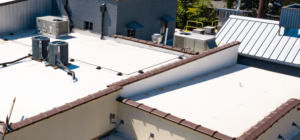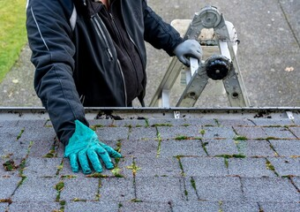The roof is a key part of a house, protecting against rain, snow, sunlight, and temperature extremes. Roofing West Chester PA involves constructing and installing a protective covering that is functional, durable, and attractive.
Rafters, or trusses, support the roof. Atop the rafters is sheathing, usually plywood or oriented strand board.

Asphalt shingles are the most popular roofing option for homeowners. They’re affordable and can last several decades under the right conditions. However, there are some things to consider before deciding on this type of roofing.
Asphalt composite shingles are much easier to install than metal or slate roofs. They’re typically made up of smaller, lighter pieces that are easier for professional roofers to handle. This can reduce labor costs and speed up the installation process overall.
Although they’re very durable, asphalt shingle roofs aren’t as long-lasting as other roofing options like metal. The average homeowner stays in a home for around 13 years, so the lifespan of your roof should reflect how long you expect to live in that location.
Asphalt shingles are susceptible to damage and deterioration from large hail and winds. It’s a good idea to have your roof inspected after any major storms. You should also schedule regular inspections with your local roofing professionals to ensure there is no damage to the underlying structure of your roof.
Asphalt roof shingles can be affected by UV rays, which can cause them to fade over time. Luckily, there are a variety of coatings that can help protect against UV rays and keep your shingles looking new.
Despite being recyclable, 11 million tons of asphalt shingles are produced each year in the United States and end up in landfills. This is a considerable amount of waste and impacts the environment significantly.
One of the most common issues with metal roofing is ‘oil canning’ which is a cosmetic deformation in the flat areas of the panels. This can be very unsightly and is caused by the growth of a bacteria called gloeocapsa magma that eats away at the metal and causes it to buckle.
Another issue with oil canning is that it can lead to corrosion of the underlying metal, which can cause leaks and other problems for your roof. This is why it’s important to work with a roofing company that understands the importance of following manufacturer guidelines during the installation process.
Metal roofing has gained popularity in recent years for both commercial and residential construction due to its longevity, durability, and low maintenance. It is available in several different panel types and colors to match the aesthetic of any home, though it can be more expensive than shingle options.
Metal roofs are made of a variety of materials, each with their own advantages and disadvantages. The most common type of metal used in roofing is steel, which can be galvanized or galvalume for added protection against corrosion. Other metal roofing options include aluminum, zinc, and weathering steel.
While metal roofs are sturdy, they can still be damaged by hail and falling tree branches. The impact can dent the metal and degrade the paint finish. If you live in an area that often experiences these types of storms, a metal roof may not be the best choice for your home.
Since metal roofs are installed in large panels, it is more difficult to replace a single damaged section than it is with shingles. This makes metal roofing more costly than shingle roofs and can increase the amount of time that it takes to complete a roof installation.
In addition, many metal roofs require an underlayment to protect the underlying structures from moisture and other environmental factors. This material is typically not included in the cost of a new metal roof and must be purchased separately.
Aside from being more costly, metal roofing is also heavier than shingles and requires a stronger structure to support it. It is important to consult with a structural engineer or roofing expert before choosing this type of roof.
In addition, some metal roofs are noisy when it rains. This is because the metal reflects the sound waves and can cause a tapping noise that some homeowners find distracting. This is not a problem for most people, but it could be an issue for those who want a quieter home. Also, if you live near tall buildings, your metal roof may be more susceptible to lightning strikes. This is because the lightning tends to strike the tallest object in the area.
Some people choose roof tiles for their beauty and the exotic sense of romance they evoke. Others appreciate the durability, longevity, and high-end look they add to a home’s design. But deciding between the various types of tiles can be difficult, since each has its own unique selling points. Choosing the right type of tile will depend on your budget, climate, and other factors, including your roof structure and walls’ ability to support the weight of the tiles.
Clay tiles are molded and baked to create a sturdy roofing material that has been in use for thousands of years. They’re available in a wide variety of colors and styles, from traditional black to earth tones to glazed tiles that mimic other roofing materials. These tiles also don’t need to be painted, so they last for as long as the roof – some temples have clay tiles that are more than 1000 years old!
Concrete tile is a popular choice for many homeowners because it’s affordable, durable and easy to work with. This material is made of cement, sand, and water and can be mixed with different colors to produce a wide variety of designs. Concrete tiles are durable and fire-resistant, and they’re available in a wide range of sizes and shapes to complement any home style.
These tiles are also popular because they’re resistant to mold, mildew and other environmental factors. They’re also a good choice for homeowners who live in warm areas, since they reflect light and help keep the interior of the house cool.
Cedar shake tiles have a natural, rustic beauty that can enhance a wide variety of architectural styles. They’re durable and naturally resistant to insects, but they require periodic cleaning, maintenance and inspections to prevent moss and fungal growth. These tiles aren’t as fire-resistant as other roofing materials, so they may not be a good choice for homes in wildfire-prone regions.
Shingles are the most common roofing material and come in many different styles. Traditionally, they are made from wood. These thin, tapered pieces of wood are primarily used to protect the home’s roof from the elements. They are made from either splits (shakes) or cuts of straight grained, knot free bolts of wood. Historically, shingles were hand split, which gave them a rustic appearance and rough texture. Currently, most shingle manufacturers saw them with a machine to give them a more uniform look and smoother finish.
Some shingles have the option to be laminated, which creates a multi-layered shingle that has more of a decorative look and may be intended to imitate other types of shingles or roofs. Laminated shingles are also more durable than traditional strip shingles and can be offered with an impact-resistant coating to provide greater protection from severe weather and wind damage.
Three-tab shingles are the most basic and affordable type of shingle. They have cutouts or “tabs” lined along their lower edges, which gives the shingle a layered appearance. Laminated shingles are thicker than 3-tab shingles and have more exposures that can help to increase a roof’s durability. Luxury shingles are thicker than dimensional shingles and are sometimes meant to imitate the appearance of slate.
A benefit of shingles is that they are lightweight, making them easier to install. They are also flexible, which can be a good thing if you plan to add a skylight or other features on your roof. However, they can be susceptible to buckling and lifting. They can also lose their granules, which can cause a roof to be less water resistant and more vulnerable to wind damage.
Regardless of the material you choose, it is important to maintain your roofing system. This will include keeping it clean and removing any debris, inspecting flashing for holes or cracks, and ensuring shingles are properly secured. Regular maintenance tasks will help to prolong the life of your shingles and keep them looking their best. If your roof is aging or you have any issues with your shingles, it is always best to contact an experienced roofing professional.

